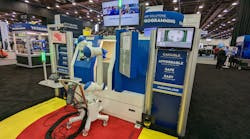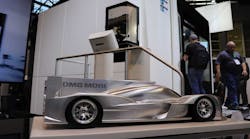Robots don’t give a damn about your feelings, and that bothers people working with and around them.
“We have been making algorithms that make robots greedy and jerky,” said Melonee Wise, vice president of robotics automation at Zebra Technologies. And by jerky, she’s not talking about sudden, jarring movements. She’s talking about machines acting like overly groomed kids in ’80s movies with their collars flipped up. “They see everything as a goal or an obstacle.”
Speaking at a panel discussion at the Automate trade show in Detroit Wednesday, Wise explained that robots have broken free from their cages—first with collaborative robots (cobots) that could safely work alongside people and more recently with the explosion of autonomous mobile robots (AMRs) that roam factory floors performing various tasks.
That robotic evolution was evident on the show floor. A decade ago, Automate was dominated by fixed, 6-axis robots, conveyor systems, and other pieces of hard-infrastructure automation. Immediately pre-COVID, cobots were the hot items with startups and established leaders showing off such models. This year, nearly everything was on wheels, with AMRs in booths at:
| 3M | ABB | Doosan |
| Fanuc | Flex Qube | Gideon |
| Kuka | Locus | MiR |
| Nachi | Otto Motors | SEW Eurodrive |
| Staubli | Yaskawa |
The problem, as Wise put it, is that the robots are doing exactly what they were programmed to do. That was fine when they were caged up and didn’t interact with people. Now that they’re roaming free, people need to feel comfortable around them, so the robots need some lessons in etiquette.
For more than a year, Wise’s team has been rewriting algorithms to focus on social cues. Some things are minor—Americans tend to walk on the right side of sidewalks and paths and pass slower-moving people on their left side. Robots were flipping a coin every time they chose where to drive and on which side to pass. The result—people didn’t like working near them because they felt rude or off.
Other behavior cues are more complicated, such as knowing that it’s okay for the robot to keep moving toward a person in the robot’s path, as long as that person is moving in a predictable way.
Ignoring social prompts isn’t just a matter of making robots feel less creepy. It’s a productivity issue. Most times, when a mobile robot encounters an obstacle, it slows down or stops to avoid collisions, then it thinks about what it should do next and picks a new path to its destination. In one video, Wise showed that a person simply crossing in front of a robot’s path caused it to pause for half a minute and then take a circuitous route to avoid where the person had been—a person who by then was nowhere near the robot. So, each of those interactions slows down the machines.
“Getting rid of these weird navigation artifacts is key to the speed of the robot,” Wise explained, adding that in one test, making robots a little more aware of human behavior increases average movement speed by 51%.
Liam Mongovan, a sales manager with Mobile Industrial Robots (MiR), said workers should expect to see more AMRs in the coming months as many companies are turning to such systems to relieve staffing shortages. Mobile robots can typically be deployed quickly, making them an attractive short-term solution.
“It’s a quick solution to the three Ds—dirty, dull or dangerous,” Mongovan said. With companies having so much trouble finding people, many are choosing AMRs where they once used forklift drivers or people sorting boxes for delivery.
“We’re talking about hours per day. How many hours of labor can you move from people to robots? That becomes how many people you can redeploy in your factory to do more valuable work,” he added.
People with several robotics companies said the large numbers of AMRs didn’t surprise them at this year’s show, much in the same way that the large numbers of cobots weren’t a surprise at IMTS 2018 or Automate 2019. Even before the pandemic, companies were seeing success stories from manufacturers using AMRs to automate the shipping of tools or supplies to workers on assembly lines, route pallets of goods to shipping docks, and perform simple production tasks such as drilling holes in workpieces.
Wise said the industry’s direction is clear—more companies will offer more mobile options, putting more workers in the paths of moving robots. As that happens, the current algorithms and safety protocols will hamper productivity, hence her group’s focus on human-robot interactions. On the plus side, her research projects have been boosting robotic performance without radically redesigning hardware. On the downside, teaching a robot decent shop-floor manners is really hard.
“It’s taken a year of research with engineers to navigation algorithm experts to show these improvements,” Wise said. “So, it’s not simple or easy, but it doesn’t involve redesigning everything else or adding expensive new components.”
















